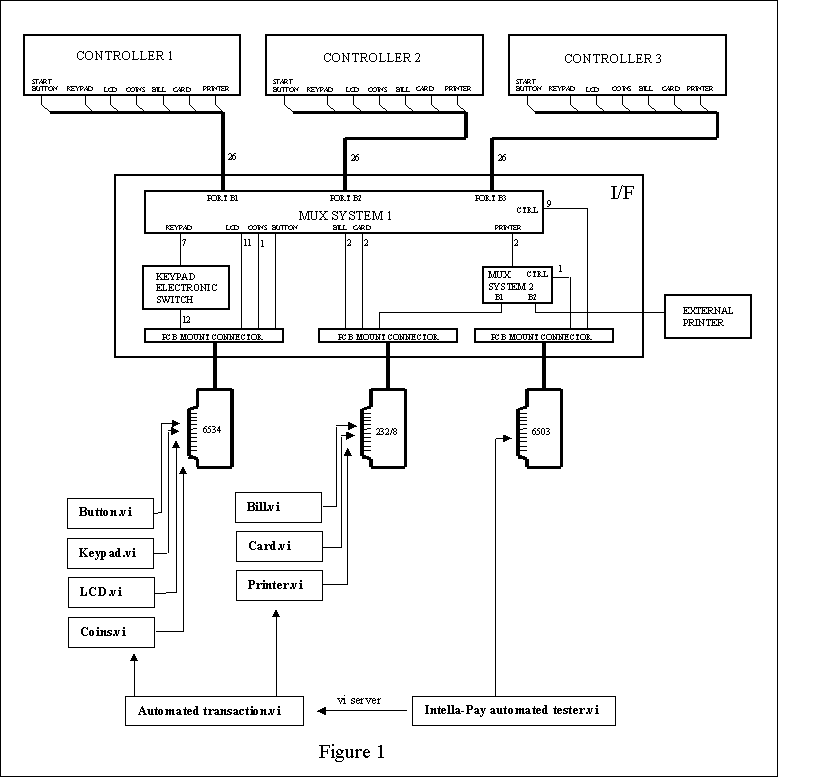
Automating The Operation Of A Parking Payment Station To Enhance Testing Capabilities
Introduction:
Digital Payment Technologies, is a high tech company located in Vancouver, Canada, providing innovative solutions for the global parking industry.
One of their products is the Intella-Pay parking payment station, composed of a controller unit (the brain of the system) and the following input/output devices: start button, keypad, LCD, three payment devices (coin acceptor, bill acceptor, card acceptor) and a ticket printer.
The controller unit was operated manually for design verification or manufacturing testing, by running transactions.
A transaction is the following sequence of interactive steps:
The operator presses a start button to initialize the controller
The controller displays on the LCD a menu with parking options
The operator selects an option using the keypad
The controller displays on the LCD a message to enter a parking stall number
The operator enters a stall using the keypad
The controller displays on the LCD a message to request making the payment
The operator makes the payment using one of the three options: bill, coins or card
The controller displays a message on the LCD, prints the ticket on the printer and stores transaction data in memory
As can be seen this is a tedious and time-consuming process when done manually, limiting testing capabilities and using resources inefficiently.
Digital Payment Technologies wanted to enhance the controller's testing capabilities and contracted us to develop a PC-based system to automate the controller's operation.
Benefits achieved:
Running continuously a high number of transactions (thousands) speed up design verification and makes possible reliability testing
Unattended automated operation frees up resources
Allow operation in a small enclosed space, away from the operator (such as doing environmental testing in a temperature chamber)
Facilitates integration with ATE systems enhancing manufacturing testing
Saves to file transaction information and test results enabling automated reporting to various departments
System Description:
National Instruments data acquisition hardware and LabVIEW for programming were selected for flexibility, easy future expansion and straightforward integration between software and hardware.
The system has the built-in capability to operate sequentially up to three controller units.
A block diagram is presented in Figure 1.
Custom-built hardware:
An interface box (I/F) was designed and built to provide signal routing from each of the three controller units to the data acquisition PC (MUX System 1) and to the emulated or physical printer (MUX System 2).
National Instruments hardware:
NI PCI-6534, High-Speed 32-bit DIO, 64MB onboard memory, was the ideal selection for the LCD emulation. It was configured in pattern I/O mode with the REQ1 line tide to the LCD Enable (E) signal coming from the controller. This way the LCD data (connected to the first two ports, configured as inputs) is acquired on every rising edge of the E signal, emulating perfectly a physical LCD. The line from the other 2 ports were used in static I/O mode to emulate the button, keypad and coin acceptor.
NI PCI-232/8, 8-Port RS-232 interface, used for emulating the RS-232 devices (bill acceptor, card acceptor and ticket printer).
NI PCI-6503, 24-bit DIO, used to control the select lines of the MUX System 1 and MUX System 2.
Custom-designed software (developed with LabVIEW):
Button.vi, Keypad.vi, LCD.vi, Coins.vi, Card.vi and Printer.vi are software emulators of each of the input/output devices.
Automated transaction.vi automates the controller's operation (running transactions) using the software emulators application listed above as sub vis.
Intella-Pay automated tester.vi is the main application, capable of testing sequentially up to three controller units by switching the MUX System 1 for each and running dynamically (using vi server) the Automated transaction.vi. The front panel allows the user to enable or bypass each unit's testing, enter operator's name and units serial numbers and for each unit independently select the payment device, number of runs, emulated or physical printer. An advantage of using vi server is the ability to run the test system from a remote location, over the LAN or Internet, by installing the main application on a PC at that location.
Performance:
By using this solution and special care in programming of the software applications, the system is capable of testing up to three controllers, running over 10,000 transactions in total, continuously and unattended, without any slowdown in execution time.
Block Diagram:

Click on the links below to see some of the software user interface panels:
Automated transaction Automated transaction DVT Intella Pay automated tester